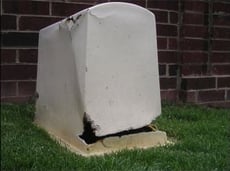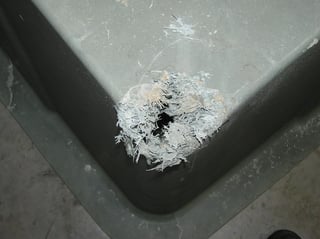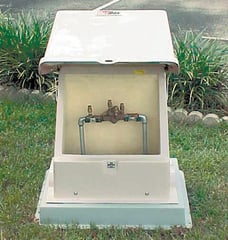So you need to choose a pump cover or backflow enclosure for installation on this latest design project you're working on. You've narrowed down your choices to either fiberglass or aluminum boxes. They both seem to come in many of the same sizes and do the same job, and there are manufacturers that offer both options for the same application. What are the main differences, and how important are they? Here are the top five questions you should ask about a fiberglass backflow enclosure.
Is a Backflow Enclosure Rugged?
 One of the common concerns with outdoor fiberglass covers is how easily they can develop holes. Weekly landscaping and maintenance can quickly cause big problems as a weed eater will cut through the fiberglass over time. Once that happens, it becomes hard to prevent freezing of the backflow prevention assemblies and causes the heater to use more electricity. Aside from freeze protection for backflow prevention devices, the equipment inside is also much more vulnerable to weather, people, and critters. On the other hand, weed eaters won't do the same thing to an aluminum enclosure. There is also a difference in how much force can be applied to each type of box. The tensile strength of most fiberglass enclosures is about 10,000 psi. The 5052-H32 marine grade aluminum that we use has a tensile strength of 33,000 psi.
One of the common concerns with outdoor fiberglass covers is how easily they can develop holes. Weekly landscaping and maintenance can quickly cause big problems as a weed eater will cut through the fiberglass over time. Once that happens, it becomes hard to prevent freezing of the backflow prevention assemblies and causes the heater to use more electricity. Aside from freeze protection for backflow prevention devices, the equipment inside is also much more vulnerable to weather, people, and critters. On the other hand, weed eaters won't do the same thing to an aluminum enclosure. There is also a difference in how much force can be applied to each type of box. The tensile strength of most fiberglass enclosures is about 10,000 psi. The 5052-H32 marine grade aluminum that we use has a tensile strength of 33,000 psi.
How Long Does A Fiberglass Enclosure Last?
Fiberglass backflow covers are susceptible to ultraviolet light deterioration. Over time, the fibers weaken and can eventually deteriorate. The typical UV protection shield many manufacturers add to their products only acts as a temporary safeguard against th e inevitable fiber blooming. This sometimes means holes in the enclosure so it needs to be patched or replaced. An outdoor custom enclosure does not suffer the same problems so you only have to make one purchase. There are even Safe-T-Covers that have been in the field for nearly 30 years with no indications that they are near the end of their useful life.
e inevitable fiber blooming. This sometimes means holes in the enclosure so it needs to be patched or replaced. An outdoor custom enclosure does not suffer the same problems so you only have to make one purchase. There are even Safe-T-Covers that have been in the field for nearly 30 years with no indications that they are near the end of their useful life.
Can You Create A Fiberglass Custom Enclosure?
Fiberglass is tough to modify and machine. Because of this, you're usually limited to only the models the manufacturer makes available. It is especially difficult to add holes or cutouts because the fiberglass is likely to chip or crack. It is also dangerous to cut, because the fine dust that occurs is abrasive to both skin and lungs. Don't forget it's fiberglass. An aluminum backflow cover can easily be customized to fit your exact specifications. Need cutouts for a louver and fan? No problem. Need it to include a heater to protect the backflow prevention assembly against freezing conditions? We can do it. Need custom sizes and want it to be large enough to cover an entire pump house? Sure thing. How about access doors and installation on a concrete slab? You got it.

Is A Fiberglass Backflow Enclosure Attractive?
It is unlikely that you, the architect, and the building owner think large beige boxes on the side of the road are particularly beautiful.  The way you get around that is by getting that backflow cover to blend in. Most leading manufacturers of fiberglass covers make them in one color - off-white. They also come in one shape according to how it is machined. With aluminum enclosures, there are many color options available from grey to blue to red. Also, the ability to customize the design and size of the box helps it blend in for a more aesthetically pleasing look.
The way you get around that is by getting that backflow cover to blend in. Most leading manufacturers of fiberglass covers make them in one color - off-white. They also come in one shape according to how it is machined. With aluminum enclosures, there are many color options available from grey to blue to red. Also, the ability to customize the design and size of the box helps it blend in for a more aesthetically pleasing look.
How Much Do Enclosures Cost?
This may come as a surprise, but in most markets aluminum is comparable in price to fiberglass. For instance, the price for a popular brand fiberglass enclosure sized to fit a .75" - 1" backflow preventer with heat is $550. A similarly sized aluminum enclosure, the 100S-AL, with heat from Safe-T-Cover is $567. If you could buy a brick house for the same price as a vinyl siding house, which would you choose when considering the durability and useful life?
Decide what's important.
If all you need is a small, temporary solution, or if your application involves corrosive materials, then some of these questions may not apply to you. Most likely, you're looking for a durable, strong, heated, attractive pump or backflow preventer cover that will last as long as the equipment inside it. You now know the five most important questions you should be asking, and we did the research for you to get the answers as well.




